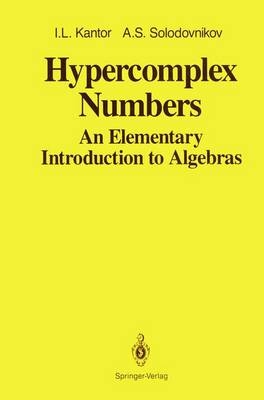
Hypercomplex Numbers
Springer-Verlag New York Inc.
978-0-387-96980-0 (ISBN)
- Titel ist leider vergriffen;
keine Neuauflage - Artikel merken
I Hypercomplex Numbers.- 1 Complex Numbers.- 1.1 Introduction.- 1.2 Operations on Complex Numbers.- 1.3 The Operation of Conjugation.- 1.4 The Absolute Value of a Complex Number: An Identity with Two Squares.- 1.5 Division of Complex Numbers.- 2 Alternate Arithmetics on the Numbers a + bi.- 2.1 Formulation of the Problem.- 2.2 Reduction to Three Systems.- 3 Quaternions.- 3.1 Preliminaries.- 3.2 The Definition of Quaternions.- 3.3 Associativity of Multiplication of Quaternions.- 3.4 Conjugation of Quaternions.- 3.5 The Quaternions as a Division System.- 3.6 Absolute Value of a Product.- 3.7 The Four-Square Identity. General Formulation of the Problem of the Sum of Squares.- 4 Quaternions and Vector Algebra.- 4.1 The Number and Vector Parts of a Quaternion.- 4.2 Scalar Product of Vectors.- 4.3 Cross Product of Vectors.- 4.4 The Geometric Interpretation of the Multiplication of a Quaternion by a Pure Vector Quaternion.- 4.5 Representation of an Arbitrary Rotation in Space by Means of Quaternions.- 4.6 The Problem of “Composition” of Rotations.- 5 Hypercomplex Numbers.- 5.1 Definition of a Hypercomplex Number System.- 5.2 Commutative Systems, Associative Systems, and Division Systems.- 6 The Doubling Procedure. Cayley Numbers.- 6.1 Another Approach to the Definition of the Quaternions.- 6.2 The Doubling of a Hypercomplex System. Definition of the Cayley Numbers.- 6.3 The Multiplication Table of the Cayley Numbers.- 6.4 Conjugation of Cayley Numbers. Absolute Values of Cayley Numbers.- 6.5 The Absolute Value of the Product of Cayley Numbers.- 6.6 The Eight-Square Identity.- 6.7 The Non-associativity of Cayley Numbers. The Alternative Property.- 6.8 The Cayley Numbers Are a Division System.- 7 Algebras.- 7.1 Heuristic Considerations.- 7.2 Definition of an Algebra.- 7.3 A Hypercomplex System as a Special Case of an Algebra.- 7.4 Commutative Algebras, Associative Algebras, and Division Algebras.- 7.5 Examples.- 7.6 An Important Example: The Algebra of n×n Matrices.- 7.7 Characterization of Multiplication in an Arbitrary Algebra.- II N-Dimensional Vectors.- 8 The N-Dimensional Vector Space An.- 8.1 Basic Definitions.- 8.2 The Concept of Linear Dependence.- 8.3 Another Definition of Linear Dependence.- 8.4 The Initial Basis.- 9 A Basis of The Space An.- 9.1 Definition of a Basis.- 9.2 Obtaining Other Bases.- 9.3 The Number of Basis Vectors.- 9.4 The Number of Vectors in a Linearly Independent System.- 9.5 A Consequence of Theorem 9.2 Pertaining to Algebras.- 9.6 Coordinates of a Vector Relative to a Basis.- 10 Subspaces.- 10.1 Definition of a Subspace.- 10.2 Examples.- 11 Lemma on Homogeneous Systems of Equations.- 12 Scalar Products.- 12.1 The Scalar Product of Geometric Vectors.- 12.2 General Definition of the Scalar Product.- 12.3 One Way of Introducing a Scalar Product.- 12.4 Length of a Vector. Orthogonal Vectors.- 12.5 Expressing a Scalar Product in Terms of Coordinates.- 12.6 Existence of a Vector Orthogonal to p Given Vectors, p < n.- 12.7 Decomposition of a Vector into Two Components.- 13 Orthonormal Basis. Orthogonal Transformation.- 13.1 Definition of an Orthonormal Basis.- 13.2 Existence of Orthonormal Bases.- 13.3 A Method for Obtaining All Orthonormal Bases.- 13.4 Orthogonal Transformations.- 13.5 The Inverse of an Orthogonal Transformation.- 13.6 “How Many” Different Orthogonal Transformations Are There?.- III The Exceptional Position of Four Algebras.- 14 Isomorphic Algebras.- 15 Subalgebras.- 16 Translation of the “Problem of the Sum of Squares” into the Language of Algebras. Normed Algebras.- 16.1 The Connection between (!) and a Certain Algebra A.- 16.2 The Possibility of Introducing a Norm in the Algebra A.- 16.3 Conclusion.- 17 Normed Algebras with an Identity. Hurwitz’s Theorem.- 17.1 Formulation of Hurwitz’s Theorem.- 17.2 Sketch of the Proof of Hurwitz’s Theorem.- 17.3 Two Lemmas.- 17.4 Conclusion of the Proof.- 18 A Method for Constructing All Normed Algebras and Its Implications for the Problem of the Sum of Squares.- 18.1 A Method for Constructing New Normed Algebras.- 18.2 Construction of All Normed Algebras.- 18.3 The Number n in the Identity (!).- 18.4 Survey of All Identities (!).- 18.5 Examples of 2- and 4-Dimensional Algebras and of the As sociated Identities (!).- 19 Frobenius’ Theorem.- 19.1 Formulation of Frobenius’ Theorem.- 19.2 Three Properties of Associative Division Algebras.- 19.3 Proof of Frobenius’ Theorem.- 19.4 Proof of the Three Assertions.- 19.5 Proof of the Generalized Frobenius Theorem Based on Hur witz’s Theorem.- 20 Commutative Division Algebras.- 20.1 Formulation of the Main Result.- 20.2 The Connection Between Multiplication in the Algebra A and Multiplication of Complex Numbers.- 20.3 Determination of the Algebra A(?, ?, ?) that is Isomorphic to the Algebra A.- 21 Conclusion.- 22 Notes.
| Reihe/Serie | Deposits, Special Pubn; 7 |
|---|---|
| Übersetzer | Abe Shenitzer |
| Zusatzinfo | Bibliography |
| Verlagsort | New York, NY |
| Sprache | englisch |
| Maße | 162 x 242 mm |
| Gewicht | 454 g |
| Themenwelt | Mathematik / Informatik ► Mathematik ► Algebra |
| ISBN-10 | 0-387-96980-2 / 0387969802 |
| ISBN-13 | 978-0-387-96980-0 / 9780387969800 |
| Zustand | Neuware |
| Informationen gemäß Produktsicherheitsverordnung (GPSR) | |
| Haben Sie eine Frage zum Produkt? |
aus dem Bereich


